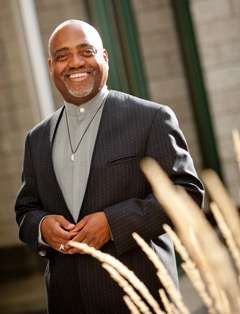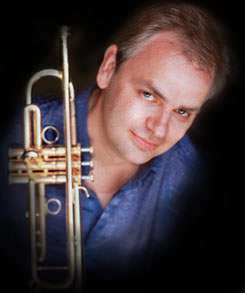|
Back
Music As Celebration New York
Isaac Stern Auditorium, Carnegie Hall
05/08/2012 -
“Spring for Music II”
Robert Rival: Lullaby (US Premiere)
John Estacio: Triple Concerto (US Premiere)
Allan Gilliland: Dreaming of the Masters III (US Premiere)
Bohuslav Martinù: Symphony No. 1, H. 289
Angela Cheng (Piano), Juliette Kang (Violin), Denise Djokic (Cello), Jens Lindemann (Trumpet)
Edmonton Symphony Orchestra, William Eddins (Music Director)

W. Eddins (© Edmonton Symphony)
After last night’s “Spring for Music” second concert, I’ll never knock America’s chauvinism again. The enthusiasts of Edmonton, Alberta, Canada make the most right-wing American Firsters look like One-World pussy-cats.
Edmontinians (Edmontoners?) packed Carnegie Hall in the thousands, waving their red banners, greeting and saluting with wild congratulations. Before the concert, not only the Executive Director of the Orchestra, Annamarie Petrov, but two Royal Canadian Mounted Police persons, stood at attention. Would they burst (I asked myself) into a patriotic anthem, with choruses shouted out by the almost-all-Edmontonian audience? Would they flash photos from a Jeanette Macdonald-Nelson Eddy Canadian operetta of the 1930’s?
That they didn’t need. The evening was devoted to the audience pride and joy, the six-decade-old Edmonton Symphony, which swept on stage, the men in red shirts, the women with red scarves, followed by their mesmeric conductor, William Eddins. In fact, Mr. Eddins was the only American-born artist of the evening. The orchestra is presumably all-Albertan (Albertish?), the trio of composers and soloists all from their oil-blessed province.
In other words, Edmonton commanded the Carnegie Hall stage, and the audience ebullience never stopped.
How good is this group? With an ensemble of 60 players, they couldn’t have essayed the Houston Symphony’s Shostakovich 11th Symphony the night before. On the other hand the one “foreign” piece, Bohuslav Martinù’s First Symphony was played with such intensity and drive by Mr. Eddins–from a dazzling scherzo to a heart-rending slow movement–that the smaller dimensions of the orchestra were no impediment.
Martinù’s orchestration is equally colorful, and dense, and it takes an orchestra of Edmonton dimensions to give transparency to a sometimes opaque palette. Like Brahms, Martinù refused to write a symphony until maturity (he was 51, living in New York), so the result is confident, assured, and a swirling, whirling joyful work.
Mr. Eddins doesn’t hide his conducting with subtle gestures, but his sweeping emotional movements achieved results, for the Martinù was a dazzling jewel. Usually when audiences applaud between movements, I am arrogantly condescending. In this case, I was emotionally bereft, since it was essential that the music glitter without stopping.
The three local works evolved from the unprepossessing to the unbelievable. The initial work, Lullaby was–unlike the celebrated lullabies of bachelors Chopin and Brahms–based on a real infant, that of composer Robert Rival. In fact, his inspiration was based on the rhythms of carrying the newborn around the house with a special pulse and meter.
The work was heartfelt, lovely, gentle, unassuming, but hardly fitting for a baby. The last measures, though, were truly sounds a baby would love: vibraphone and woodblock, with soft strings in the background.
John Estacio’s Triple Concerto was played only once, at its premiere for the Edmonton Concert Hall some 15 years ago, and Mr. Estacio edited the original one for this Carnegie Hall (and basically world) premiere. He is apparently a most prolific composer, recently commissioned to write several (!!) operas. For this work, the composer accurately wrote of it as a series of “memory pieces”, with solo violin and piano taking the initial piano cadenza and transforming it as through the prism of time. Those initial three solos ranged on the ultra-romantic, but Mr. Estacio didn’t let that deter him. Orchestra and soloists worked through the “memories” with consummate, confident playing.
With only one movement (and a few mini-movements inside), Mr. Estacio delivered a variety of moods challenging soloists against orchestra. But nothing was laggard, for Mr. Estacio’s inspiration (and 15 years of editing!!) transformed the difficult genre into a sparkling whole.
If the original Triple Concerto was as good as this, there seemed no reason for not piercing the concerto repertoire. Except (and it’s a big exception), that it is usually impossible to find three competent soloists to take a chance with anything except the Beethoven Triple Concerto. Perhaps this most prolific composer could ;consider transforming it into a piano concerto, which would have no lack of eager performers.

J. Lindemann (© trumpetsolo.com)
These works, though, were the preludes to the most devastating work of the evening, Allan Gilliland’s Dreaming of the Masters III, with possibly the most exciting trumpet player (or musician!) in the world, Jens Lindemann. The soloist happily swaggered on stage, spoke a few works to the audience, and started three incendiary movements., The first, 101 Damnations (sic) was like a Big Band sound magnified! Not so much brassy Stan Kenton but orchestral Maynard Ferguson. This was followed by six of the audience, standing and whirling plastic tubes to make a diggereedoo haunting moaning sound for Mr. Linedmann’s fluegelhorn.
For the finally, Lower Neighbors, Canadian Gilliland wasn’t paying homage to us in the US of A, but Latin Tino Puento style music. Mr. Lindemann stood at the back of the Edmonton and started music which has the velocity of a Paganini etude–utterly faultlessly.
That was hardly the end. For an encore, the orchestra playing an electifhing “Mambo” from West Side Story, with Messrs Eddins and Lindemann dancing through this total celebration.
Harry Rolnick
|